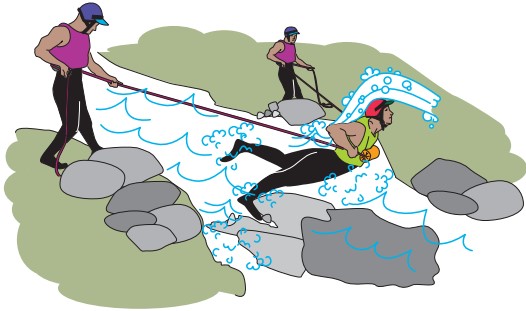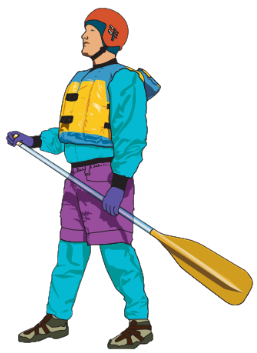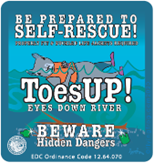River Education and Safety
The South Fork American River is a dynamic water environment. Water levels and conditions can change without warning. Proper Personal Protective Equipment (PPE), Information, training and gear are very important to having a fun and safe experience on the river. Consider using a professional outfitter familiar with the area.


Before You Go
- Check your equipment and supplies.
- Personal Floatation Devices (PFDs) are required to be worn on the South Fork American River on any floatation device.
- Plan for the water. The air may be warm, but the water is cold. A Wet suit or Dry suit may be recommended.
- Use river shoes or sandals. Don’t use Flip Flops on the river.
- Sun protection is important. Use sunscreen and consider long sleeves and a hat if not using a helmet.
- Use sunglasses with a retention strap such as Croakies.
- Bring water and snacks.
- Have a change of clothes for the takeout.
- Check weather and road conditions.
River Safety Education

River Flow is measure in Cubic Feet per Second (CFS). One cubic foot of water is 7.5 Gallons and weighs about 63 pounds.
River conditions change dramatically depending on flow levels.
Hypothermia can happen quickly in cold water. Proper attire and quality gear are very important.
River safety is everyone’s responsibility. Proper education and equipment are important to prevent injury and loss. Familiarize yourself with local ordinances as well as understanding safe river practices.
High Water Considerations
When river flows are higher than you’re familiar with on the river, here are some things to think about before deciding to get on the river:
Preparation, Planning, Skills
- Advanced boating skills are recommended.
- Inner tubing at higher flows on any section of the South Fork American River is not advisable.
- Some Rapids may be more difficult and less forgiving than at regular flows.
- Time between rapids can be greatly reduced.
- Guides should have experience on large volume and pushy flows.
- Self-rescue knowledge is crucial (ex. recovery from flips, aggressively swimming to safety).
- Knowledge of standard hand signals may be helpful.
- River rescue training experience is recommended.
- The “normal route” through a rapid may no longer work, due to large waves and holes that form at higher water levels.
- Scout a rapid if you do not know the high-water route.
- Due to cold water and strainers, long swims are extremely hazardous.
- Single boat trips should be avoided.Gear Guy.PNG
- Know emergency egress locations and have an emergency plan.
- Use proper boat spacing (stay close together).
Equipment

- Dress warm (wear a wetsuit or drysuit) – Avoid cotton clothing!
- Wear a life jacket designed for paddle sports (no horseshoe or waterski vests).
- Use multi-chambered whitewater rafts only.
- Rig for flips - No loose lines or gear.
- Bring extra paddles and warm dry clothing.
Group Fitness
- Long, hard paddling may be needed at higher water.
- You should have the ability to help rescue yourself or others.
Cold Water Dangers
- Your body loses heat and strength quickly.
- You can quickly lose your ability to swim to safety, rescue yourself or others.
If you are not familiar with the concepts listed above, consider going with a permitted outfitter with professionally trained guides. You can access a list of permitted outfitters on our American River Rafting Outfitters page.
Tuber Tips and Safety
Tubing the South Fork American River can be exciting and fun. Follow these tips for a safe and memorable trip:
 Wear an appropriate Personal Floatation Device (life jacket) Coast guard approved. PFD’s are required to be worn on the South Fork American River on any floatation device.
Wear an appropriate Personal Floatation Device (life jacket) Coast guard approved. PFD’s are required to be worn on the South Fork American River on any floatation device.- Wear good water shoes with a heal strap. Flip flops come off easy and get lost and walking on rocky ground can cause injuries.
- Use sunscreen – even on cloudy days. The water also reflects a lot of the suns light. Reapply the sunscreen often.
- Toes and nose up if you flip off your tube. Do not stand up in moving water. River bottoms are rocky and may have logs that can trap your feet. Stay on your back and use a back stroke to get to the shore.
- Hydrate – especially if consuming alcohol. Water is the only way to properly hydrate.
- Don’t bring glass bottles. Broken glass is a serious hazard. Glass bottles or cups are restricted by County of El Dorado to 100 feet away from the river on all public land.
 Have a plan – know where you need to take out of the river. It is recommended to not float past Henningsen Lotus Park or possibly Camp Lotus.
Have a plan – know where you need to take out of the river. It is recommended to not float past Henningsen Lotus Park or possibly Camp Lotus.- Respect private property – There are many private homes along the River. Do not trespass on private land unless it is an emergency. Know where the Quiet Zone is and keep splashing, yelling and rough housing to a minimum.
- Don’t litter – pack out and dispose of trash properly. Each year volunteers remove tons of garbage from the river. Respect the environment.
- Inner tubing at higher flows on any section of the South Fork American River is not advisable.